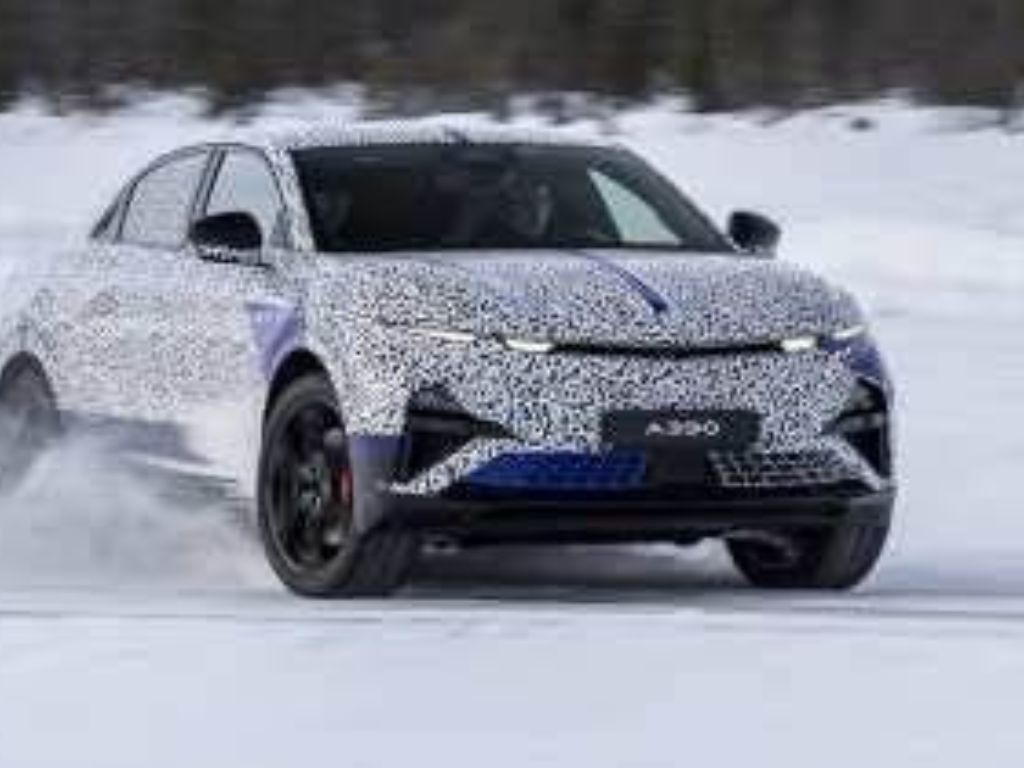Renault’s sporty division, Alpine, presently only produces the Alpine A220, a modified version of the Renault 5. Perhaps more significant is its upcoming car, the A390, which is the brand’s first custom EV and is aimed at Porsche Macan EV consumers. It promises aggressive looks and a driving experience that matches.
It falls somewhere between a crossover and a hatchback, being around five inches shorter and four inches lower than a Tesla Model Y. Although it incorporates design elements from the A110 sports car, this four-door variant with a liftback rear also demonstrates the direction the brand’s design language is headed.
Aggression is the main focus of the front, which includes small headlight projectors farther down where we’re usually accustomed to seeing a car’s fog lights, as well as high-set daytime running lights with extra LED elements below that seem to resemble rain (Alpine claims they’re inspired by mountains). The back of the car lacks a full-width light bar, and the lower fascia also has air intakes with active shutters. This design is replicated throughout the vehicle.
Alpine and Renault components are mixed together within. For a car like this, the Alpine-only steering wheel looks appropriately sporty. Although the screens are repurposed from other Renault products, the designers aimed to create a wraparound effect in the cockpit by tilting the primary panel in the direction of the driver. The two screens’ Alpine-specific visuals appear to have been successful in establishing a sporting atmosphere within the cabin.
Only the tri-motor all-wheel drive system, which uses one motor for each wheel to provide torque vectoring in the back, is available for the A390. The base A390 GT can go from zero to 62 mph (100 km/h) in 4.8 seconds and up to 124 mph (200 km/h) thanks to its 396 horsepower and 479 lb-ft (650 Nm) of torque.
The A360 GTS is the most potent version, at least for the time being. It can produce 463 horsepower and 596 lb-ft (808 Nm), which reduces the sprint time to 3.9 seconds and raises the highest speed to 137 mph (220 km/h). Both models have the same 89-kWh battery pack and the same WLTP range rating of 323 to 345 miles (520 to 555 km), which probably relies on the wheel size (20- or 21-inch wheels are offered for the car).
Its AmpR Medium chassis is similar to that of vehicles like the Nissan Ariya and the Renault Megane E-Tech, but it has a custom suspension system and faster steering. Better handling response and more comfort are two benefits of its hydraulic bump stops. Alpine decided to outfit it with four-corner 365-millimeter rotors with six-piston calipers on the front, resulting in a 49/51 weight distribution.
With an onboard charger that supports both vehicle-to-load (V2L) and vehicle-to-grid (V2G) capabilities, DC fast charging at up to 190 kilowatts is sufficient for a 15 to 80% charging period of less than 25 minutes. As long as the camping location is close to paved roads, this might be a decent EV for camping thanks to its 18.8 cu. ft (532-liter) trunk and bidirectional charging capacity.
Although the exact price has not been announced, it is expected to be priced to directly compete with its primary rivals, the Maserati Grecale Folgore and the Macan EV. Alpine had previously stated that it hoped to join the U.S. market in 2027, but with the Trump administration’s increased import taxes and general anti-EV policies, it’s unclear if that plan is still in place—it probably isn’t.
It’s unclear whether the French-built A390 would have made it to American shores in the first place because Alpine also stated that it would introduce larger models especially for the American market. Alpine will probably continue to be a Euro-only brand if the brand decides it is not profitable to start selling cars here at this time. The future electric replacement for the A110 sports car was originally planned to be marketed in the United States.

